Miele G 886 User Manual
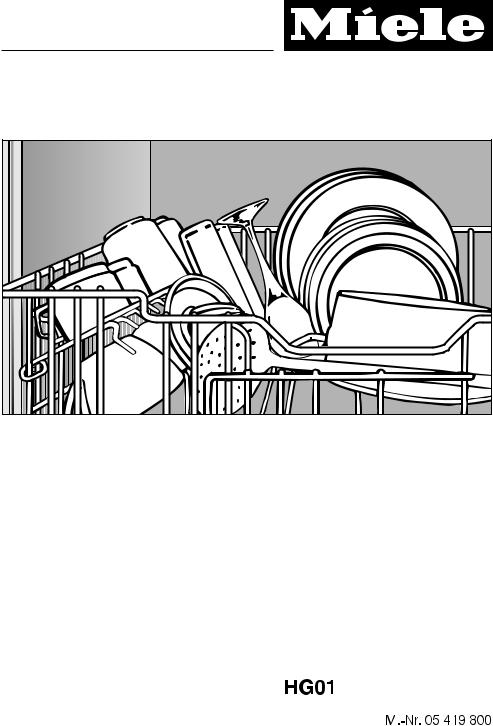
Operating instructions
for G 886 dishwasher
To prevent accidents and |
|
ö] |
machine damage, read |
|
|
the Operating Instructions |
|
|
before installing or using |
|
|
the machine. |
|
|
|
|

Contents
Guide to the appliance . . . . . . . . . . . . . . . . . . . . . . . . . . . . . . . . . . . . . . . . . . . . . 4 View of the dishwasher . . . . . . . . . . . . . . . . . . . . . . . . . . . . . . . . . . . . . . . . . . . . . . 4
Control panel (fascia ) . . . . . . . . . . . . . . . . . . . . . . . . . . . . . . . . . . . . . . . . . . . . . . . 5
IMPORTANT SAFETY INSTRUCTIONS . . . . . . . . . . . . . . . . . . . . . . . . . . . . . . . . . 6
INSTRUCTIONS IMPORTANTES SUR LA SÉCURITÉ . . . . . . . . . . . . . . . . . . . . . 8
Caring for the environment . . . . . . . . . . . . . . . . . . . . . . . . . . . . . . . . . . . . . . . . . 10 Disposal of the packing
material . . . . . . . . . . . . . . . . . . . . . . . . . . . . . . . . . . . . . . . . . . . . . . . . . . . . . . . . . 10 Disposal of an old machine . . . . . . . . . . . . . . . . . . . . . . . . . . . . . . . . . . . . . . . . . . 10 Energy saving washing . . . . . . . . . . . . . . . . . . . . . . . . . . . . . . . . . . . . . . . . . . . . . 10
Before using for the first time. . . . . . . . . . . . . . . . . . . . . . . . . . . . . . . . . . . . . . . 11 To open the door . . . . . . . . . . . . . . . . . . . . . . . . . . . . . . . . . . . . . . . . . . . . . . . . . . 12
To close the door . . . . . . . . . . . . . . . . . . . . . . . . . . . . . . . . . . . . . . . . . . . . . . . . . . 12 Child Safety Lock. . . . . . . . . . . . . . . . . . . . . . . . . . . . . . . . . . . . . . . . . . . . . . . . . . 12 Water softener . . . . . . . . . . . . . . . . . . . . . . . . . . . . . . . . . . . . . . . . . . . . . . . . . . . . 13 Programming and setting the water hardness level . . . . . . . . . . . . . . . . . . . . . . . 14 Programming and changing the water hardness level. . . . . . . . . . . . . . . . . . . 14 Setting the water hardness selector in the wash cabinet . . . . . . . . . . . . . . . . . 15
Before using for the first time. . . . . . . . . . . . . . . . . . . . . . . . . . . . . . . . . . . . . . . 16 Filling the salt reservoir . . . . . . . . . . . . . . . . . . . . . . . . . . . . . . . . . . . . . . . . . . . . . 16
Salt indicator . . . . . . . . . . . . . . . . . . . . . . . . . . . . . . . . . . . . . . . . . . . . . . . . . . . . . 17 Rinse aid . . . . . . . . . . . . . . . . . . . . . . . . . . . . . . . . . . . . . . . . . . . . . . . . . . . . . . . . 18 Adding rinse aid . . . . . . . . . . . . . . . . . . . . . . . . . . . . . . . . . . . . . . . . . . . . . . . . . . 18 Rinse aid indicator . . . . . . . . . . . . . . . . . . . . . . . . . . . . . . . . . . . . . . . . . . . . . . . . . 19 Setting the dosage. . . . . . . . . . . . . . . . . . . . . . . . . . . . . . . . . . . . . . . . . . . . . . . . . 20
Loading the dishwasher . . . . . . . . . . . . . . . . . . . . . . . . . . . . . . . . . . . . . . . . . . . 21 Loading examples . . . . . . . . . . . . . . . . . . . . . . . . . . . . . . . . . . . . . . . . . . . . . . . . . 22
Upper basket . . . . . . . . . . . . . . . . . . . . . . . . . . . . . . . . . . . . . . . . . . . . . . . . . . 22 Adjustable cup racks . . . . . . . . . . . . . . . . . . . . . . . . . . . . . . . . . . . . . . . . . . . . 23 Adjusting the upper basket . . . . . . . . . . . . . . . . . . . . . . . . . . . . . . . . . . . . . . . 24 Lower basket . . . . . . . . . . . . . . . . . . . . . . . . . . . . . . . . . . . . . . . . . . . . . . . . . . 25 Glassware insert . . . . . . . . . . . . . . . . . . . . . . . . . . . . . . . . . . . . . . . . . . . . . . . 26 Bottle holder . . . . . . . . . . . . . . . . . . . . . . . . . . . . . . . . . . . . . . . . . . . . . . . . . . . 26 Cutlery . . . . . . . . . . . . . . . . . . . . . . . . . . . . . . . . . . . . . . . . . . . . . . . . . . . . . . . 27
Items not suitable for dishwashers . . . . . . . . . . . . . . . . . . . . . . . . . . . . . . . . . . . . 28
2

Contents
Operating the dishwasher. . . . . . . . . . . . . . . . . . . . . . . . . . . . . . . . . . . . . . . . . . 29 Adding detergent. . . . . . . . . . . . . . . . . . . . . . . . . . . . . . . . . . . . . . . . . . . . . . . . . . 29
Program selection . . . . . . . . . . . . . . . . . . . . . . . . . . . . . . . . . . . . . . . . . . . . . . . . . 30 Turning on the dishwasher . . . . . . . . . . . . . . . . . . . . . . . . . . . . . . . . . . . . . . . . . . 31 Starting a program. . . . . . . . . . . . . . . . . . . . . . . . . . . . . . . . . . . . . . . . . . . . . . . . . 31 Program sequence indicator lights . . . . . . . . . . . . . . . . . . . . . . . . . . . . . . . . . . . . 32 Time display. . . . . . . . . . . . . . . . . . . . . . . . . . . . . . . . . . . . . . . . . . . . . . . . . . . . . . 32 Light ring . . . . . . . . . . . . . . . . . . . . . . . . . . . . . . . . . . . . . . . . . . . . . . . . . . . . . . . . 32 At the end of a program. . . . . . . . . . . . . . . . . . . . . . . . . . . . . . . . . . . . . . . . . . . . . 33 Turning off the dishwasher. . . . . . . . . . . . . . . . . . . . . . . . . . . . . . . . . . . . . . . . . . . 33 Interrupting a program. . . . . . . . . . . . . . . . . . . . . . . . . . . . . . . . . . . . . . . . . . . . . . 34 Changing a program . . . . . . . . . . . . . . . . . . . . . . . . . . . . . . . . . . . . . . . . . . . . . . . 34 Additional features . . . . . . . . . . . . . . . . . . . . . . . . . . . . . . . . . . . . . . . . . . . . . . . . . 35
“Top Solo” . . . . . . . . . . . . . . . . . . . . . . . . . . . . . . . . . . . . . . . . . . . . . . . . . . . . . 35 Delay start. . . . . . . . . . . . . . . . . . . . . . . . . . . . . . . . . . . . . . . . . . . . . . . . . . . . . 37 Unloading the dishwasher . . . . . . . . . . . . . . . . . . . . . . . . . . . . . . . . . . . . . . . . . . 39
Cleaning and care . . . . . . . . . . . . . . . . . . . . . . . . . . . . . . . . . . . . . . . . . . . . . . . . 40 “Filter” indicator light . . . . . . . . . . . . . . . . . . . . . . . . . . . . . . . . . . . . . . . . . . . . . . . 40
Cleaning the filters in the wash cabinet. . . . . . . . . . . . . . . . . . . . . . . . . . . . . . . . . 40 Cleaning the spray arms . . . . . . . . . . . . . . . . . . . . . . . . . . . . . . . . . . . . . . . . . . . . 42 Cleaning the wash cabinet . . . . . . . . . . . . . . . . . . . . . . . . . . . . . . . . . . . . . . . . . . 43 Cleaning the door and the door seal . . . . . . . . . . . . . . . . . . . . . . . . . . . . . . . . . . . 43 Cleaning the control panel. . . . . . . . . . . . . . . . . . . . . . . . . . . . . . . . . . . . . . . . . . . 43 Cleaning the door panel . . . . . . . . . . . . . . . . . . . . . . . . . . . . . . . . . . . . . . . . . . . . 43
Problem solving guide . . . . . . . . . . . . . . . . . . . . . . . . . . . . . . . . . . . . . . . . . . . . 44
Solving problems . . . . . . . . . . . . . . . . . . . . . . . . . . . . . . . . . . . . . . . . . . . . . . . . . 52 Cleaning the water intake filter . . . . . . . . . . . . . . . . . . . . . . . . . . . . . . . . . . . . . . . 52
Cleaning the drain pump and non-return valve . . . . . . . . . . . . . . . . . . . . . . . . . . 53
After sales service . . . . . . . . . . . . . . . . . . . . . . . . . . . . . . . . . . . . . . . . . . . . . . . . 55
Special accessories . . . . . . . . . . . . . . . . . . . . . . . . . . . . . . . . . . . . . . . . . . . . . . 56
Transport . . . . . . . . . . . . . . . . . . . . . . . . . . . . . . . . . . . . . . . . . . . . . . . . . . . . . . . 57
Program chart. . . . . . . . . . . . . . . . . . . . . . . . . . . . . . . . . . . . . . . . . . . . . . . . . . . . 58
Technical data . . . . . . . . . . . . . . . . . . . . . . . . . . . . . . . . . . . . . . . . . . . . . . . . . . . 60
3
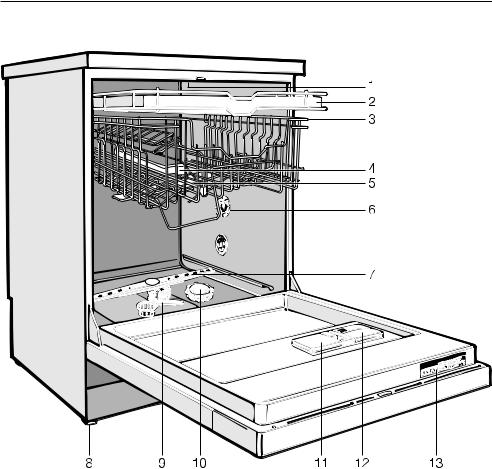
Guide to the appliance
View of the dishwasher
1 |
Upper spray arm (not visible) |
8 |
Four height adjustable feet |
2 |
Cutlery tray (select models) |
9 |
Filter combination |
3 |
Upper basket |
10 |
Salt reservoir |
4 |
Water feed for middle spray arm |
11 |
Dual compartment detergent |
5 |
Middle spray arm |
|
dispenser |
|
|
||
6 |
Water hardness selector |
12 |
Rinse aid reservoir |
|
(with dosage selector) |
||
|
|
|
|
7 |
Lower spray arm |
13 |
Data plate |
|
|
4
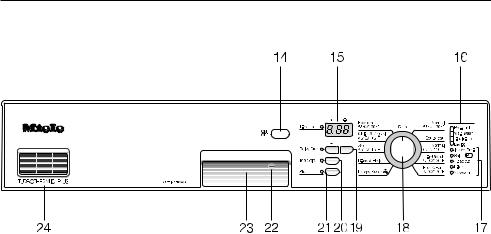
Guide to the appliance
Control panel (fascia )
14 |
“On/Off” button |
20 |
“Top Solo” button |
15 |
Time display |
21 |
“Start” button |
16 |
Program sequence display |
22 |
Child safety lock |
17 |
Check/Refill indicators |
23 |
Door release |
18 |
Program selector with light ring |
24 |
Vent for drying fan |
19 |
“Delay Start” buttons |
|
|
5

IMPORTANT SAFETY INSTRUCTIONS
WARNING
Please follow all basic safety precautions when operating this dishwasher.
This appliance conforms with all uniform safety codes and regulations. To avoid injury and machine damage, read the operating instructions carefully.
The manufacturer cannot be held responsible for damage or injury caused by improper use or for uses other than those for which the appliance is intended.
Repairs should only be performed by a qualified and competent person. Disconnect the appliance from the power supply before servicing (pull out
the plug or “trip” the circuit breaker).
This dishwasher should only be installed under a continuous
countertop secured to adjacent cabinetry.
The dishwasher must be electrically grounded. Install the dishwasher as outlined in the included In-
stallation instructions.
Only use detergents and rinse aids recommended for residential dish-
washers.
Do not use the dishwasher unless all panels are in place.
Do not allow children to play in or on the dishwasher.
Keep all detergents and rinse aids out of the reach of children.
Dishwasher detergents contain Sodium Silicate and Sodium
Carbonate. In case of eye contact, immediately flush with water.
Call a physician or poison control.
Do not tamper with the controls.
Do not drink water from the dishwasher.
6

IMPORTANT SAFETY INSTRUCTIONS
When loading dishes and cutlery:
–Place sharp items away from the door seal to prevent damaging the seal.
–Load knives pointing down to prevent injuries.
Do not wash plastic items unless they are labeled “dishwasher safe”.
For items not labeled, check the manufacturer’s recommendations.
Do not abuse, sit, or stand on the door or baskets of the dishwasher.
When disposing of a dishwasher, unplug it from the outlet, remove
the front door and cut off the power cord. This will help protect children from injury and accidentally locking themselves in.
Under certain conditions, hydrogen gas may be produced in a hot wa-
ter system that has not been used for two weeks or more. HYDROGEN GAS IS EXPLOSIVE. If the hot water system has not been used for such a period, turn on all hot water faucets and let the water flow from each for several minutes before using the dishwasher. This will release any accumulated hydrogen gas. Do not smoke or use an open flame during this time.
SAVE THESE INSTRUCTIONS
7

INSTRUCTIONS IMPORTANTES SUR LA SÉCURITÉ
AVERTISSEMENT
Au moment d’utiliser votre lave-vaisselle, veuillez observer toutes les mesures de sécurité de base.
Cet appareil électroménager est conforme à tous les règlements et codes sur la sécurité. Pour éviter de vous blesser et d’endommager l’appareil, veuillez lire soigneusement les instructions sur l’utilisation.
Le fabricant ne peut être tenu responsable des dommages ou blessures causés par une utilisation inadéquate ou par des utilisations autres que celles auxquelles l’appareil est destiné.
Les réparations doivent être effectuées uniquement par une
personne compétente. Débrancher l’appareil de la prise de courant avant d’en faire l’entretien (enlever la fiche de la prise ou fermer le disjoncteur).
Installer uniquement ce lave-vaisselle sous un comptoir
continu qui est fixé à des meubles adjacents.
Vous devez mettre le lave-vaisselle à la terre. Installer le lave-vaisselle
en observant les instructions pour l’installation ci-jointes.
Utiliser uniquement des détersifs et des produits de rinçage
recommandés pour les lave-vaisselle domestiques.
Ne pas utiliser le lave-vaisselle à moins que tous les panneaux
soient bien en place.
Ne pas permettre aux enfants de jouer dans ou sur le lave-vaisselle.
Ranger tous les détersifs et produits de rinçage hors de la
portée des enfants.
Les détersifs pour lave-vaisselle contiennent du silicate de soude et
du carbonate de soude. En cas de contact avec les yeux, les rincer immédiatement à grande eau. Téléphoner à un médecin ou à un centre de traitement antipoison.
Ne pas modifier les commandes.
Ne pas boire l’eau du meuble de lavage.
8

INSTRUCTIONS IMPORTANTES SUR LA SÉCURITÉ
Au moment de remplir le lave-vaisselle :
–Mettre les articles pointus de manière à ce qu’ils n’endommagent pas le seau étanche de la porte.
–Mettre le tranchant des couteaux vers le bas afin d’éviter les risques de blessure.
Ne pas laver les articles en plastique à moins qu’ils n’indiquent
‘’Va au lave-vaisselle’’. Vérifier les recommandations du fabricant pour les articles non étiquetés.
Ne pas abuser et ne pas vous asseoir ni vous tenir sur la porte ou
sur les paniers du lave-vaisselle.
Enlever la porte et couper le cordon du lave-vaisselle avant de
l’enlever aux déchets afin d’empêcher les enfants de se blesser ou de s’enfermer dans l’appareil par accident.
Dans certaines conditions, un système d’eau chaude qui n’a pas
été utilisé pendant plus de deux semaines, peut dégager de l’azote. L’AZOTE EST EXPLOSIF. Si le système d’eau chaude n’a pas été utilisé pendant une telle période de temps, ouvrir tous les robinets d’eau chaude et laisser l’eau couler pendant plusieurs minutes avant d’utiliser le lave-vaisselle. Ceci dissipera tout l’azote accumulé. Ne pas fumer ni utiliser une flamme nue durant ce temps.
CONSERVER CES INSTRUCTIONS.
9

Caring for the environment
Disposal of the packing material
The cardboard box and packing material protects the appliance during shipping. These materials are biodegradable and recyclable, please recycle.
Disposal of an old machine
Before disposing of an appliance make sure that the machine has been made safe as outlined in the “Important Safety Instructions” by removing power cords and doors.
Energy saving washing
This dishwasher is exceptionally economical in the use of water and electricity. For best results follow these tips:
The dishwasher can internally heat water to the temperatures required by the wash program. This capability allows the option of connecting the machine to either a hot or cold water source.
^For lowest energy consumption and the gentlest washing of china and crystal, connect the dishwasher to a cold water source.
^For fastest possible wash times, yet higher energy consumption, connect the dishwasher to a hot water source.
^Make full use of the baskets without overloading for the most economical washing.
^For small loads:
Select the “Top Solo” function (see “Additional features”).
^Choose a program that best suits the degree of soiling and the type of dishes being washed.
^If baskets are only half full, select the “Economy” program.
^Use the correct amounts of detergent and rinse aid.
10

Before using for the first time
Before using for the first time, please note the following.
Setting the water softener
The water softener must be set to correspond to the water hardness in your area. The water hardness can be determined by calling your local water company, or by using a test kit that can be purchased from the Miele Technical service Department.
The salt reservoir must only be filled with water and salt. Never fill it with detergent.
Adding rinse aid
Accidentally filling the rinse aid reservoir with detergent will damage the reservoir.
Only use detergents and rinse aids formulated for domestic dishwashers.
Choose the correct program
Wash programs should be selected depending on load size and degree of soiling. See the Program Chart for program descriptions.
Add correct detergent amount
Generally, 1 ½ tablespoons (25 ml) of detergent is enough for most normally soiled loads. Not enough or too much detergent can lead to poor wash results. See “Adding detergent”.
Cleaning results vary among detergent brands. If you are not satisfied with the wash results, try another brand of detergent.
Load dishes correctly
Load dishes so that water can reach all surfaces. Check that the spray arms are not blocked by tall or large items. If necessary, manually rotate the spray arms to check clearance.
The combination filter in the base of the wash cabinet and the spray arms must be kept clean.
These should be regularly inspected and cleaned.
See the “Cleaning and care” section for more detailed information.
Every dishwasher is tested before leaving the factory. Any water remaining in the machine is from these tests and does not indicate that the machine has been used.
11
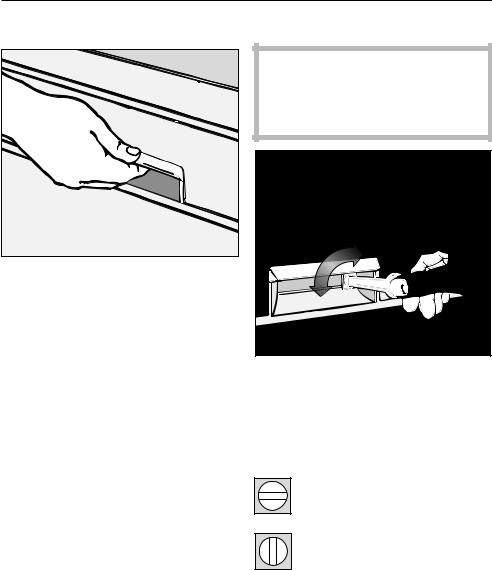
Before using for the first time
To open the door |
Child Safety Lock |
^Press the release catch inside the door grip.
If the door is opened during operation, all functions will be interrupted.
To close the door
^Push the baskets in.
^Lift the door and push until it clicks into position.
The yellow key for the Child Safety Lock is shipped on one of the spikes at the front of the upper basket. Remove the key before using the dishwasher.
The Child Safety Lock is designed to prevent children from opening the dishwasher.
^Use the provided key to lock or unlock the Child Safety Lock.
Horizontal =
the door is locked
Vertical =
the door can be opened
12

Before using for the first time
Water softener
To achieve good cleaning results, the dishwasher needs soft water. Hard water results in the build up of calcium deposits on tableware and in the dishwasher. If your tap water hardness is above 8 gr/gal (140 ppm), the water should be softened. This takes place automatically in the integrated water softener.
–The water softener must be filled with dishwasher salt for reactivation.
–The dishwasher must be programmed to correspond to the water hardness in your area.
–Your local water authority will be able to advise you of the water hardness level in your area.
If the hardness of your tap water is constantly lower than 8 gr/gal (140 ppm), do not add dishwasher salt. However, the dishwasher must still be programmed to correspond to the water hardness level in your area.
Where the water hardness fluctuates e.g. between 9 - 17 gr/gal
(160 - 310 ppm), always program the machine to the higher value (17 gr/gal, 310 ppm in this example).
If there is a fault, it will help the service technician to know the hardness of your tap water.
^ Enter the water hardness below:
gr/gal (ppm)
Settings
|
|
Setting shown in |
gr/gal |
ppm |
time display |
|
|
|
1 |
20 |
1 |
2 |
40 |
2 |
3 |
50 |
3 |
4 |
70 |
4 |
5 |
90 |
5 |
6 |
110 |
6 |
7 |
130 |
7 |
8 |
140 |
8 |
9 |
160 |
9 |
10 |
180 |
10 |
11 |
200 |
11 |
12 |
220 |
12 |
13 |
230 |
13 |
14 |
250 |
14 |
15 |
270 |
15 |
16 |
290 |
16 |
17 |
310 |
17 |
18 |
320 |
18 |
19 |
340 |
19 |
20 |
360 |
20 |
21 |
380 |
21 |
22 |
400 |
22 |
23 |
410 |
23 |
24 |
430 |
24 |
25 |
450 |
25 |
26 |
470 |
26 |
27 |
490 |
27 |
28 |
500 |
28 |
29 |
520 |
29 |
30 |
540 |
30 |
31 |
560 |
31 |
32 |
580 |
32 |
33 |
590 |
33 |
34 |
610 |
34 |
35 |
630 |
35 |
36-70 |
650-1260 |
36 |
|
|
|
*The dishwasher is programmed at the factory for a water hardness level of 4 gr/gal (70 ppm).
13

Before using for the first time
Programming and setting the water hardness level
The water hardness level of your water supply must be programmed into the dishwasher using the buttons on the control panel. The water hardness selector in the wash cabinet is then also set to the water hardness level in your area.
Programming and changing the water hardness level
The water hardness level which has been programmed into the machine can be checked and adjusted by using the buttons on the control panel.
^Turn the appliance off with the “On/Off” button.
^Press $and “Start” simultaneously and at the same time turn the dishwasher on using the “On/Off” button.
A “P” and 2 figures will appear in the time display.
^Turn the program selector to “Sani Wash”.
The value corresponding to the programmed water hardness level e.g. “22” will appear in the time display.
The water hardness level is 22 gr/gal (400 ppm).
If the water hardness level in memory is the correct one:
^Turn the appliance off with the “On/Off” button.
If you wish to program a different water hardness level:
^Press the “Top Solo” button repeatedly until the value corresponding to your water hardness level appears in the display. This figure will be in gr/gal. For instance if your water hardness level is 30 gr/gal (540 ppm) then the figure “30” will show in the display.
Note:
Once the figure “36” is reached the counter returns to “1”.
^ Press the “Start” button.
“SP” appears in the time display.
^ Press the “Start” button again.
The new water hardness level is stored in memory.
The running time of the program which the selector dial is set to is now shown in the display in hours and minutes.
The “Time Left” indicator next to the time display lights up.
^Turn the program selector to the “Stop” position.
^Turn off the dishwasher with the “On/Off” button.
14
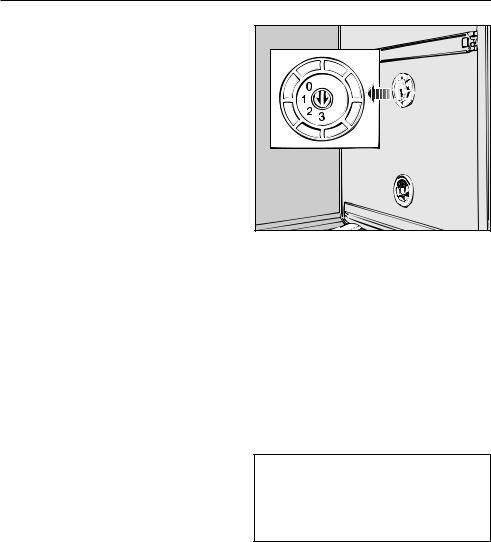
Before using for the first time
Setting the water hardness selector in the wash cabinet
^Turn off the dishwasher with the “On/Off” button.
The water hardness selector in the wash cabinet must be set according to the following table.
The correct water hardness setting will enhance wash results. Too high a setting will lead to poor cleaning results and an increase in water spots left on glasses, dishes and cutlery.
^Use a screwdriver to take the cover off the water hardness selector in the wash cabinet.
^Use a coin or screwdriver to adjust the water hardness selector. There is a click as each setting is
reached.
gr/gal |
ppm |
Selector |
|
|
setting (level) |
|
|
|
1- 7 |
20130 |
3 |
8-10 |
140180 |
2 |
11-14 |
200250 |
1 |
15-70 |
270-1260 |
0 |
|
|
|
The water hardness selector is preset to setting “3”.
Example:
For a water hardness level of 8 gr/gal (140 ppm).
Turn the water hardness level selector to setting 2 (8 - 10 gr/gal).
^Return the cover on the water hardness selector.
15
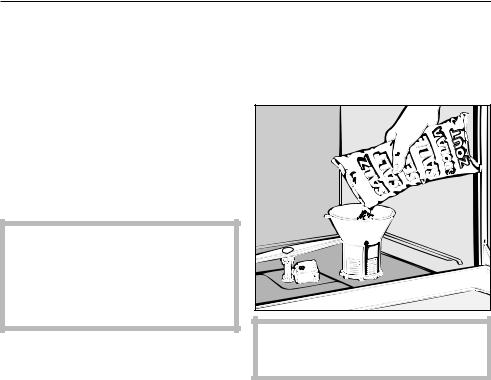
Before using for the first time
Filling the salt reservoir
If your water hardness level is greater than 8 gr/gal, the salt reservoir should be filled before the first use and when the “Salt” indicator lights. Only use water softener reactivation salt (1 - 4 mm grain size); other salts may contain insoluble additives which can impair the water softener.
The salt reservoir holds approximately 4 lbs (2 kg) of salt.
Inadvertently filling the salt reservoir with dishwashing detergent will damage the water softener. Make sure that only water softener reactivation salt of the proper grain size is used.
To fill the salt reservoir:
^Remove the lower basket.
^Unscrew and remove the salt reservoir cap.
Before adding salt for the first time, fill the reservoir with approximately 2 quarts (2 l) of water.
^Place the provided funnel over the salt reservoir.
^Carefully fill with salt, grain size of
1 - 4 mm. The salt reservoir holds approximately 4 lbs (2 kg) of salt depending of the brand used. As it is filled, water will run out.
^Clean any excess salt from the threads of the reservoir opening.
^Screw the cap on firmly.
If the dishwasher will not be used immediately after reactivation, run the “Rinse & Hold” program. This will remove any traces of salt from inside the wash cabinet.
16
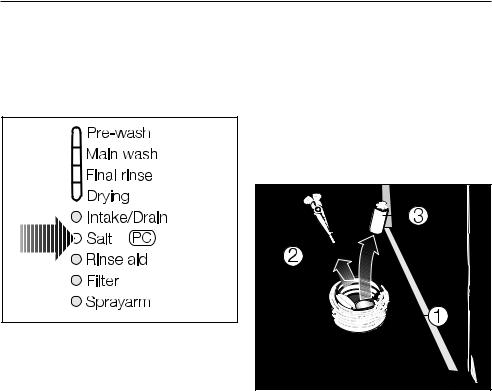
Before using for the first time
Salt indicator
When the salt reservoir is empty, the “Salt-PC” indicator will light, indicating that it should be refilled with reactivation salt.
After the reservoir has been filled, the water softener is automatically reactivated the next time the dishwasher is started. The “Softener” indicator will light during this process.
Note:
If your water is soft (below 8 gr/gal) the salt reservoir should not be filled with salt. The indicator will remain lit and should be disregarded or deactivated.
The “Salt-PC” indicator has also been designed so that future program updates can be entered into the dishwasher. See the “After Sales Service”.
Bypassing the Salt indicator
To bypass the salt indicator, you will need a screwdriver and needle nose pliers.
^ Remove the salt reservoir cap.
Looking into the salt reservoir, you will see the top of the float chamber on the right hand side b.
^Using a screwdriver, carefully pivot the float chamber towards the center of the reservoir.
^Using needle nose pliers, pull off the cap c from the float chamber and remove the float d.
^Replace the float chamber cap, push the chamber back into its upright position, and replace the salt reservoir cap. The indicator should now remain off.
17
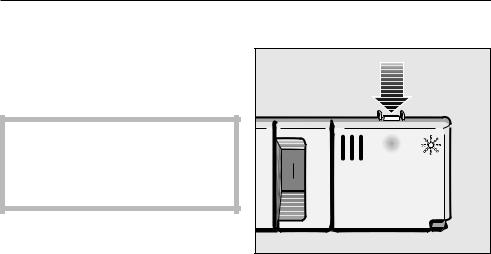
Before using for the first time
Rinse aid
Rinse aid is recommended to prevent spotting on dishes and glassware that normally occurs during the drying cycle.
Filling the rinse aid reservoir with detergent will damage the reservoir. Only pour rinse aid formulated for residential dishwashers into the reservoir.
Adding rinse aid
^Add rinse aid before the first use and when ever the “Rinse aid” indicator lights.
^Press the button in the direction of the arrow until the flap springs open.
18

Before using for the first time
Rinse aid indicator
The rinse aid indicator on the control panel will light when the rinse aid reservoir needs refilling.
^Pour liquid rinse aid into the reservoir until it is visible on the surface of the
screen. Do not refill until the “Rinse aid” indicator lights.
Only use rinse aid labeled for residential dishwashers. Inadvertently adding detergent to the rinse aid dispenser will damage the dispenser.
^Press on the flap until you hear it click shut. Failure to close it all the way will allow water to enter the reservoir during the wash program.
^Wipe up any spilled rinse aid.
The flap will remain closed during normal operation.
There will be enough rinse aid left for 2 - 3 washes after it first lights.
19
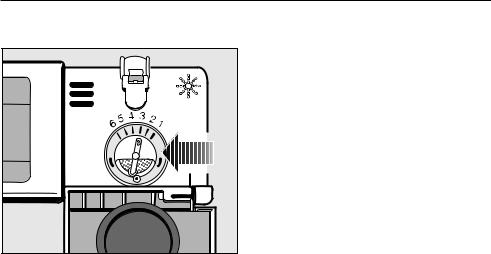
Before using for the first time
Setting the dosage
The dosage selector is preset to 3. This dispenses approximately 3 ml of rinse aid per program. It can be adjusted from 1 to 6, depending on your needs.
^Use a higher setting if spots appear on dry glassware.
^Use a lower setting if streaking appears on dishes or glasses.
20
